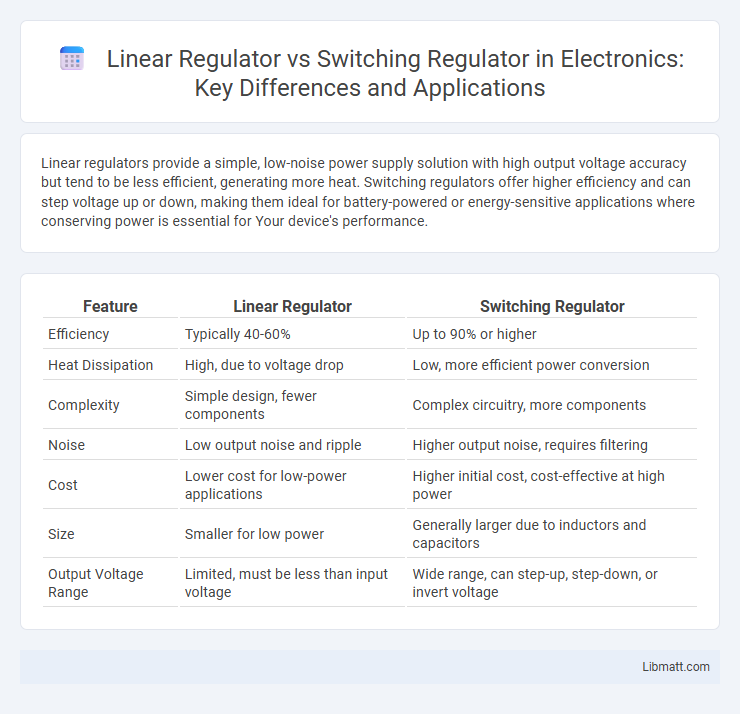Linear regulators provide a simple, low-noise power supply solution with high output voltage accuracy but tend to be less efficient, generating more heat. Switching regulators offer higher efficiency and can step voltage up or down, making them ideal for battery-powered or energy-sensitive applications where conserving power is essential for Your device's performance.
Table of Comparison
| Feature | Linear Regulator | Switching Regulator |
|---|---|---|
| Efficiency | Typically 40-60% | Up to 90% or higher |
| Heat Dissipation | High, due to voltage drop | Low, more efficient power conversion |
| Complexity | Simple design, fewer components | Complex circuitry, more components |
| Noise | Low output noise and ripple | Higher output noise, requires filtering |
| Cost | Lower cost for low-power applications | Higher initial cost, cost-effective at high power |
| Size | Smaller for low power | Generally larger due to inductors and capacitors |
| Output Voltage Range | Limited, must be less than input voltage | Wide range, can step-up, step-down, or invert voltage |
Introduction to Voltage Regulators
Voltage regulators maintain a stable output voltage despite input voltage fluctuations or varying load conditions, essential for protecting sensitive electronic components. Linear regulators provide a simple, low-noise solution by dissipating excess voltage as heat, ideal for low power applications. Switching regulators, with higher efficiency, use inductors and capacitors to convert and regulate voltage, making them suitable for applications requiring power conservation and higher current delivery.
What is a Linear Regulator?
A linear regulator is an electronic voltage regulator that maintains a steady output voltage by dissipating excess input voltage as heat through a pass transistor operating in the linear region. It offers low output noise and simple design, making it suitable for low-power applications requiring clean and stable voltage. However, linear regulators are less efficient than switching regulators, especially when the input-output voltage difference is significant, as power loss directly translates to heat generation.
What is a Switching Regulator?
A switching regulator is a power supply component that efficiently converts one voltage level to another using high-frequency switching elements and energy storage components such as inductors and capacitors. Unlike linear regulators, switching regulators minimize energy loss by rapidly turning the input voltage on and off, resulting in higher efficiency and less heat generation. Your choice of a switching regulator is ideal for applications requiring efficient power conversion and longer battery life.
Key Differences: Linear vs Switching Regulators
Linear regulators provide voltage regulation by dissipating excess power as heat, offering simple design and low noise but lower efficiency, especially with significant voltage drops. Switching regulators use inductors, capacitors, and switches to convert voltages efficiently, achieving higher efficiency and better thermal performance but with more complex circuits and potential electromagnetic interference (EMI). The choice between linear and switching regulators depends on application requirements for power efficiency, heat dissipation, noise sensitivity, and circuit complexity.
Efficiency Comparison
Linear regulators offer lower efficiency, typically ranging from 30% to 60%, as they dissipate excess voltage as heat, making them suitable for low power applications. Switching regulators achieve much higher efficiency levels, often between 80% and 95%, by using high-frequency switching and energy storage elements to efficiently convert voltage. The choice between the two depends on power requirements and thermal management constraints, with switching regulators favored where efficiency and battery life are critical.
Heat Dissipation and Thermal Management
Linear regulators dissipate excess voltage as heat, resulting in significant thermal challenges especially in high-voltage-drop or high-current applications, requiring efficient heat sinks to prevent overheating. Switching regulators convert voltage by rapidly switching elements on and off, greatly improving efficiency and reducing heat generation, which minimizes the need for extensive thermal management. Effective thermal management in switching regulators often involves careful PCB layout and component selection to handle the intermittent currents and electromagnetic interference.
Noise and Output Ripple Considerations
Linear regulators produce minimal noise and very low output ripple, making them ideal for sensitive analog and RF circuits requiring clean power. Switching regulators generate higher noise and output ripple due to high-frequency switching, which can interfere with noise-sensitive applications unless proper filtering and layout techniques are employed. Your choice should balance power efficiency and noise tolerance based on the specific requirements of your electronic design.
Application Suitability and Use Cases
Linear regulators excel in low-noise, low-power applications such as audio equipment, precision sensors, and portable devices due to their simplicity and minimal electromagnetic interference. Switching regulators are ideal for high-efficiency power conversion in applications like battery-powered systems, DC-DC converters, and voltage step-up/step-down scenarios requiring significant voltage changes. Your choice depends on factors like power efficiency, heat dissipation, and noise sensitivity specific to your device's operational requirements.
Cost Factors and Design Complexity
Linear regulators generally have lower initial costs and simpler design due to fewer components and straightforward circuitry, making them ideal for low-power applications. Switching regulators tend to incur higher costs and greater design complexity because of their need for inductors, capacitors, and more intricate control circuitry to achieve higher efficiency. Your choice will depend on balancing budget constraints with the desired performance and efficiency requirements.
Choosing the Right Regulator for Your Project
Linear regulators provide simple, low-noise voltage regulation ideal for low-power applications where efficiency is less critical, but they dissipate excess power as heat. Switching regulators offer higher efficiency and better thermal management for projects requiring significant current or battery-powered designs, though they generate more electrical noise. Selecting the right regulator hinges on your project's power requirements, size constraints, noise tolerance, and efficiency goals to optimize performance and reliability.
Linear regulator vs Switching regulator Infographic

 libmatt.com
libmatt.com